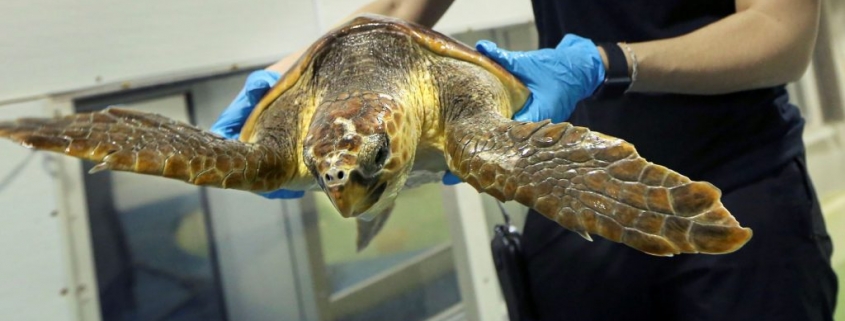An Endangered Turtle Was Killed on a North Carolina Beach in an Illegal Off-Roading Incident
Each time you slide behind the wheel, you’re supposed to do everything in your power to ensure you follow car safety rules so that your actions don’t endanger others. It doesn’t matter if you’re on the highway or off-roading — you must follow the rules and remain alert for both human and animal life to avoid accidents. A single bad choice behind the wheel can trigger devastating consequences.
A perfect example of this recently took place in a National Park. A driver decided to ignore the fact that a beach that’s part of the National Park system was off-limits to off-roading. Their actions cost an endangered sea turtle her life.
The off-roading accident that led to the death of an endangered turtle
KIRO 7 recently reported the sad news that one of the sea turtles that use the beach that makes up part of the Cape Hatteras National Seashore was recently found lying, deceased, on the sand. Evidence strongly suggests that the turtle was struck and run over by a vehicle that was off-roading on the beach.
It’s always heartbreaking when a turtle is hit and killed. They’re a peaceful animal that lacks the speed and agility needed to avoid motorists. Making this story even sadder is that this was a loggerhead sea turtle, an endangered species that had crawled out of the sea to lay eggs. Because this is the time of year that the loggerhead sea turtles always lay their eggs, that section of the beach had been closed off to traffic in an attempt to provide the turtles with some much-needed privacy and protection. Clearly, someone ignored the signs and decided to go off-roading on the beach.
What is so special about loggerhead sea turtles?
Loggerhead turtles take their name from the fact that they have powerful jaws and heads that appear massive compared to their shelled body. While loggerhead turtles are the most commonly found sea turtles in the Atlantic Ocean waters that border the Eastern United States, the population has been in a state of rapid decline. Ocean pollution, destruction of nesting habitats, and fishing habits have decimated the loggerhead turtle population.
What’s really alarming about the decline in loggerhead numbers is that they are considered a keystone species that plays a pivotal role in the Atlantic Ocean’s ecosystem.
The Loggerhead is considered a “keystone species,” meaning that other animals in its ecosystem depend on it for survival,” Joel Sartore wrote in a National Geographic article. “These turtles feed on invertebrates, whose shells pass through their digestive systems and, upon excretion, fall back to the bottom of the ocean for other animals to eat as a calcium source. Predators also rely on loggerhead hatchlings for food, while more than a hundred species of animals — including barnacles, crabs, and algae — live on their shells.
National Geographic
According to the South Carolina Department of Natural Resources, the loggerhead turtle was originally put on the Endangered and Threatened Species List on July 28, 1978.
The truth about off-roading on federal land
While off-roading isn’t exactly prohibited on Federal land, there are strict rules drivers are expected to follow. If you want to go off-roading in one of the national parks, you must understand that while some areas allow you to off-road, the National Park Service (NPS) also has several areas where off-roading is banned.
If you want to go off-roading in a national park, the first thing you have to do is purchase a permit from the NPS. The second order of business is directly contacting the park’s management team that you’re visiting. Don’t be surprised if you’re told that the park staff doesn’t allow you to take your vehicle off-road in any part of the park. Most national parks aren’t equipped to deal with the damage off-roading does to the wildlife and flora. The few national parks that allow you to go off-roading have particular areas where you’re allowed to drive and usually limit the number of drivers who can enjoy the experience.
Failing to follow the rules the NPS has regarding off-roading in parks will result in severe consequences. The driver who chose to ignore the signs about not driving on the beach where the turtles were nesting faces a $5,000 fine and a possible six-month jail sentence for driving in a restricted area. An additional $5,000 fine and six months of jail time could be added if they’re also found guilty of violations to wildlife/plants/natural features. Since their actions directly resulted in the death of an endangered species, they could be convicted of violating the Endangered Species Act, which includes a maximum sentence of one year in prison and a $50,000 fine. Additional civil penalties that add up to $25,000 could be attached.
When you look at how much a guilty conviction could cost the drivers, the few minutes of fun they may have experienced while driving on the beach doesn’t seem worthwhile.
RELATED: Where You Can Take Your Boat to See the Best Marine Wildlife
The post An Endangered Turtle Was Killed on a North Carolina Beach in an Illegal Off-Roading Incident appeared first on MotorBiscuit.







